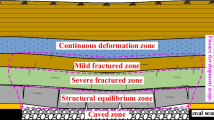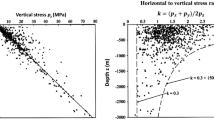Abstract
Hydraulic fracturing, a highly efficient well-stimulation technique, can be utilised to significantly increase production from unconventional low-permeability rocks like shale. This is achieved through creating fractures in the formation by injecting a solution of water, sand, and chemicals. These fractures may make it easier for the hydrocarbons to enter the wellbore. Proppant is essential in the hydraulic fracturing technique since it is employed to maintain the fractures open. Therefore, the movement and placement of the proppant are crucial elements that determine the conductivity and efficiency of the propped fracture. In this study, the efficacy of water and liquid nitrogen (LN) as fracturing fluids is examined. In order to analyse elucidate the factors controlling the phenomenon of proppant transportation, volume percent of sand (proppant), proppant density, fluid viscosity, fluid velocity, and proppant diameter have been examined in this study. The concepts of proppant volume fraction (V.F.) contour, equilibrium dune height (EDH, in mm) and equilibrium dune level (EDL, in %) have been established in this study. Water was observed to have higher proppant carrying capacity than LN. The developed model was validated against published information. Reduction in proppant density was found to have a significant impact on its placement. Major findings of this study shall assist in comprehending the proppant movement and placement during the course of fracturing and ultimately in improving the job performance.






























Similar content being viewed by others
Abbreviations
- \(\dot{m}\) :
-
Interphase mass transfer
- \(\overrightarrow{F}\) :
-
Body forces on solid-phase
- \(\overrightarrow{\tau }\) :
-
Phase stress–strain tensor
- \(\overrightarrow{u}\) :
-
Velocity vector
- k:
-
Interphase exchange coefficient
- ρ:
-
Density in kg/m3
- α:
-
Volume fraction
- V.F.:
-
Proppant volume fraction
- R:
-
Interaction forces between phases
- P:
-
Pressure
- V:
-
Velocity in m/s
- D:
-
Diameter of the proppant in mm
- η:
-
Viscosity in Pa.s
- EDH:
-
Equilibrium Dune Height in mm
- EDL:
-
Equilibrium Dune Level in %
- ft. /min:
-
Feet-per-minute
- m/s:
-
Meter-per-second
- LN:
-
Liquid Nitrogen
- EGT:
-
Eulerian-Granular Technique
- s:
-
Solid-phase
- f:
-
Fluid-phase
- q:
-
Phase (particle or gas)
- fs:
-
Interphase between solid and fluid phase
References
Temizel C, Canbaz CH, Saracoglu O, et al (2020) Production forecasting in shale reservoirs using LSTM method in deep learning. In: Unconventional Resources Technology Conference. Society of Petroleum Engineers, Tulsa, OK, USA
Temizel C, Canbaz CH, Betancourt D, et al (2020) A comprehensive review and optimization of artificial lift methods in unconventionals. In: Annual Technical Conference and Exhibition. Society of Petroleum Engineers, Virtual
Hari S, Krishna S, Patel M et al (2022) Influence of wellhead pressure and water cut in the optimization of oil production from gas lifted wells. Pet Res 7:253–262. https://doi.org/10.1016/j.ptlrs.2021.09.008
Sivakumar P, Krishna S, Hari S, Vij RK (2020) Electromagnetic heating, an eco-friendly method to enhance heavy oil production: a review of recent advancements. Environ Technol Innov. https://doi.org/10.1016/j.eti.2020.101100
Pandian S, Dahyalal PC, Krishna S et al (2021) A study on cashew nut shell liquid as a bio-based flow improver for heavy crude oil. J Pet Explor Prod Technol 11:2287–2297. https://doi.org/10.1007/s13202-021-01162-w
Krishna S, Sreenivasan H, Nair R (2018) Hydraulic fracture studies of reservoirs with an emphasis on pore fracture geometry studies by developing fracture and microseismic estimations. Ann Geophys 61:1–14. https://doi.org/10.4401/ag-7638
Hari S, Krishna S, Gurrala LN et al (2021) Impact of reservoir, fracturing fluid and proppant characteristics on proppant crushing and embedment in sandstone formations. J Nat Gas Sci Eng. https://doi.org/10.1016/j.jngse.2021.104187
Ren L, Lin R, Zhao J (2018) Stimulated reservoir volume estimation and analysis of hydraulic fracturing in shale gas reservoir. Arab J Sci Eng 43:6429–6444. https://doi.org/10.1007/s13369-018-3208-0
Song W, Jinzhou Z, Yongming L (2014) Hydraulic fracturing simulation of complex fractures growth in naturally fractured shale gas reservoir. Arab J Sci Eng 39:7411–7419. https://doi.org/10.1007/s13369-014-1221-5
Tan P, Jin Y, Hou B et al (2019) Experimental investigation of hydraulic fracturing for multi-type unconventional gas Co-exploitation in ordos basin. Arab J Sci Eng 44:10503–10511. https://doi.org/10.1007/s13369-019-03974-9
Li J, Li B, Lu J et al (2022) Evolution of fracture permeability and its compressibility in proppant-supported shale. J Nat Gas Sci Eng. https://doi.org/10.1016/j.jngse.2022.104713
Hou L, Wang X, Bian X et al (2022) Evaluating essential features of proppant transport at engineering scales combining field measurements with machine learning algorithms. J Nat Gas Sci Eng. https://doi.org/10.1016/j.jngse.2022.104768
Zhang T, Li C, Shi Y et al (2022) Numerical simulation of proppant directly entering complex fractures in shale gas. J Nat Gas Sci Eng. https://doi.org/10.1016/j.jngse.2022.104792
Roostaei M, Nouri A, Fattahpour V, Chan D (2018) Numerical simulation of proppant transport in hydraulic fractures. J Pet Sci Eng 163:119–138. https://doi.org/10.1016/j.petrol.2017.11.044
Wen Z, Zhang L, Tang H et al (2022) A review on numerical simulation of proppant transport: Eulerian–Lagrangian views. J Pet Sci Eng. https://doi.org/10.1016/j.petrol.2022.110902
Li H, Huang B, Zhao X et al (2022) Effects of fluid and proppant properties on proppant transport and distribution in horizontal hydraulic fractures of coal under true-triaxial stresses. J Nat Gas Sci Eng 108:104795. https://doi.org/10.1016/j.jngse.2022.104795
Li H, Huang B, Zhao X et al (2022) Experimental investigation on proppant transport and distribution characteristics in coal hydraulic fractures under true triaxial stresses. J Pet Sci Eng 218:110993. https://doi.org/10.1016/j.petrol.2022.110993
Smith MB, Bale A, Britt LK et al (2001) Enhanced 2D proppant-transport simulation: the key to understanding proppant flowback and post-frac productivity. SPE Prod Facil 16:50–57. https://doi.org/10.2118/69211-PA
Zhang H, Chen J, Zhao Z, Qiang J (2023) Hydraulic fracture network propagation in a naturally fractured shale reservoir based on the “well factory” model. Comput Geotech 153:105103. https://doi.org/10.1016/j.compgeo.2022.105103
Kulkarni MC, Ochoa OO (2012) Mechanics of light weight proppants: a discrete approach. Compos Sci Technol 72:879–885. https://doi.org/10.1016/j.compscitech.2012.02.017
Yue M, Zhang Q, Zhu W et al (2020) Effects of proppant distribution in fracture networks on horizontal well performance. J Pet Sci Eng 187:106816. https://doi.org/10.1016/j.petrol.2019.106816
Chang O, Dilmore R, Wang JY (2017) Model development of proppant transport through hydraulic fracture network and parametric study. J Pet Sci Eng 150:224–237. https://doi.org/10.1016/j.petrol.2016.12.003
Shi F, Wang XL, Liu C et al (2018) An XFEM-based numerical model to calculate conductivity of propped fracture considering proppant transport, embedment and crushing. J Pet Sci Eng 167:615–626. https://doi.org/10.1016/j.petrol.2018.04.042
Wang HY, Sharma MM (2018) Modeling of hydraulic fracture closure on proppants with proppant settling. J Pet Sci Eng 171:636–645. https://doi.org/10.1016/j.petrol.2018.07.067
Huang H, Babadagli T, Li HA et al (2019) Effect of injection parameters on proppant transport in rough vertical fractures: an experimental analysis on visual models. J Pet Sci Eng 180:380–395. https://doi.org/10.1016/j.petrol.2019.05.009
Rivas E, Gracie R (2019) Numerical considerations for the simulation of proppant transport through fractures. J Pet Sci Eng 180:1006–1021. https://doi.org/10.1016/j.petrol.2019.05.064
Feng ZG (2014) Direct numerical simulation of forced convective heat transfer from a heated rotating sphere in laminar flows. J Heat Transfer. https://doi.org/10.1115/1.4026307
Feng ZG, Michaelides EE (2004) The immersed boundary-lattice Boltzmann method for solving fluid-particles interaction problems. J Comput Phys 195:602–628. https://doi.org/10.1016/j.jcp.2003.10.013
Pan TW, Joseph DD, Bai R et al (2002) Fluidization of 1204 spheres: simulation and experiment. J Fluid Mech 451:169–191. https://doi.org/10.1017/s0022112001006474
Radjaï F, Dubois F (2011) Discrete-element modelling of granular materials. Wiley-ISTE, London
Munjiza A (2004) The combined finite-discrete element method. Wiley, London
Crowe CT, Schwarzkopf JD, Sommerfeld M, Tsuji Y (2011) Multiphase flows with droplets and particles. CRC Press, London
Zaman AU, Bergstrom DJ (2014) Implementation of two-fluid model for dilute gas-solid flow in pipes with rough walls. J Fluids Eng Trans ASME 136:1–11. https://doi.org/10.1115/1.4026282
Bonamy D, Chavanis PH, Cortet PP et al (2009) Euler-like modelling of dense granular flows: application to a rotating drum. Eur Phys J B 68:619–627. https://doi.org/10.1140/epjb/e2009-00123-6
Chiesa M, Mathiesen V, Melheim JA, Halvorsen B (2005) Numerical simulation of particulate flow by the Eulerian–Lagrangian and the Eulerian–Eulerian approach with application to a fluidized bed. Comput Chem Eng 29:291–304. https://doi.org/10.1016/j.compchemeng.2004.09.002
Reuge N, Cadoret L, Coufort-Saudejaud C et al (2008) Multifluid Eulerian modeling of dense gas-solids fluidized bed hydrodynamics: influence of the dissipation parameters. Chem Eng Sci 63:5540–5551. https://doi.org/10.1016/j.ces.2008.07.028
(2017) ANSYS-FLUENT User’s Guide - Release 18.1. Canonsburg, PA
Ding J, Gidaspow D (1990) A bubbling fluidization model using kinetic theory of granular flow. AIChE J 36:523–538. https://doi.org/10.1002/aic.690360404
Syamlal M, Rogers W, O`Brien TJ (1993) MFIX documentation theory guide
Patankar SV (2018) Numerical heat transfer and fluid flow. CRC Press, London
Hu X, Wu K, Li G et al (2018) Effect of proppant addition schedule on the proppant distribution in a straight fracture for slickwater treatment. J Pet Sci Eng 167:110–119. https://doi.org/10.1016/j.petrol.2018.03.081
Tong S, Mohanty KK (2016) Proppant transport study in fractures with intersections. Fuel 181:463–477. https://doi.org/10.1016/j.fuel.2016.04.144
Drylie S, Duenckel R, Barree R, Hlidek B (2018) An investigation of proppant transport in friction reducer fluid systems utilizing a large slot flow apparatus. In: Annual Technical Conference and Exhibition. Society of Petroleum Engineers, Texas, USA
Wang J, Joseph DD, Patankar NA et al (2003) Bi-power law correlations for sediment transport in pressure driven channel flows. Int J Multiph Flow 29:475–494. https://doi.org/10.1016/S0301-9322(02)00152-0
Wen H, Yang R, Huang Z et al (2020) Numerical simulation of proppant transport in liquid nitrogen fracturing. J Nat Gas Sci Eng. https://doi.org/10.1016/j.jngse.2020.103657
Funding
This research received no specific grant from any funding agency in the public, commercial, or not-for-profit sectors.
Author information
Authors and Affiliations
Contributions
SP: Conceptualization, Software and Visualization. IW: Software and Visualization. HS: Formal Analysis and Data Curation. PN: Formal Analysis and Validation. PG: Formal Analysis and Validation. SK: Methodology, Writing—Original Draft Preparation, Reviewing and Editing. All authors have read and approved the manuscript.
Corresponding author
Ethics declarations
Conflict of interest
The authors have no competing interests to declare that are relevant to the content of this article.
Additional information
Publisher's Note
Springer Nature remains neutral with regard to jurisdictional claims in published maps and institutional affiliations.
Rights and permissions
Springer Nature or its licensor (e.g. a society or other partner) holds exclusive rights to this article under a publishing agreement with the author(s) or other rightsholder(s); author self-archiving of the accepted manuscript version of this article is solely governed by the terms of such publishing agreement and applicable law.
About this article
Cite this article
Patel, S., Wilson, I., Sreenivasan, H. et al. Proppant transportation and placement in fractures by water and liquid nitrogen: a numerical simulation. Comp. Part. Mech. 11, 721–743 (2024). https://doi.org/10.1007/s40571-023-00649-z
Received:
Revised:
Accepted:
Published:
Issue Date:
DOI: https://doi.org/10.1007/s40571-023-00649-z




